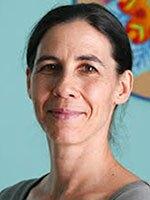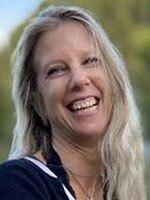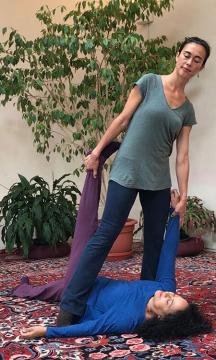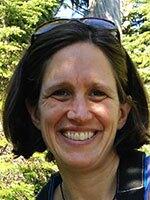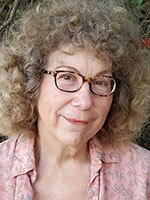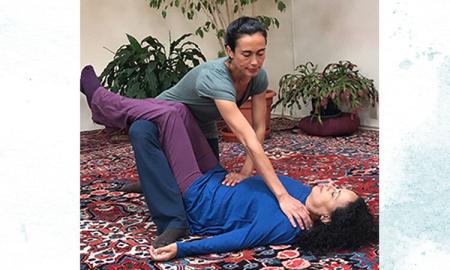
3 MTS EXPLAIN HOW BREEMA SUPPORTS THEIR PRACTICE
September 25, 2023
Elaine Pendergrast
Breema is a holistic system consisting of Breema bodywork, Self-Breema movements, and the Nine Principles of Harmony. All three aspects are a support for being present both in bodywork practice and in daily life.
For this article, the author interviewed three active licensed massage professionals, who are also long-time Breema practitioners and instructors. All three said Breema is foundational to enhancing their self-care and client care, and finding long-term fulfillment as massage therapists.
Katherine Correa
A licensed massage practitioner for 38 years, and a Certified Breema Instructor for 31 years, Katherine Correa lives in Summertown, Tennessee, where she teaches Breema and practices massage, Breema, Feldenkrais, and Ortho-Bionomy.
“My mother did massage with us at home,” said Correa. “At college, when a friend asked for a massage, I felt insecure about doing it outside my family. After giving it and seeing how interested I was, I enrolled in massage school.”
At that school, an instructor who was also a Breema instructor gave Correa a session. She explained, “I experienced being present in a way so completely new and different I immediately recognized I wanted that for my life.” So she started studying Breema.
The direction in Breema is to come to body-mind connection by bringing the mind to be with the activity of the body, and coming back to that if the mind wanders.
“When I remember body-mind connection, I’m connected to myself, so there’s ‘somebody home’ to connect with the recipient,” Correa said. “Then it doesn’t matter if I’m doing massage or Breema—the atmosphere includes and accepts us both as we are, nothing needs to be different, and whatever I’m doing has more meaning. Otherwise, I’m simply going through the motions, which is meaningless. Without body- mind connection, I’m lost.”
People in Correa’s area do a lot of physical work and want traditional massage, especially because of back pain and tension, Correa said. So she frequently combines about a half-hour of Breema with a half-hour of massage.
Doing Breema, Correa uses her whole body while the client lies on the floor. “Working on the arms with my feet as well as my hands is useful for construction workers, hairdressers, gardeners, people on computers all the time,” she explained. “I can give them a lot of body weight, and at the same time take care of myself.”
When the client moves to the table, Breema still informs her sessions. Breema uses the body’s weight instead of force—there’s no pushing or pulling, no pressing.
“Instead, I take hold of their arm or leg and lean my body in one direction or another to move the client’s body around. I position my hands on their body and lean in, only as far as my body is comfortable,” Correa said. “At least one of the Breema Principles—such as Body Comfortable, No Force, and Firmness and Gentleness—is always in play on the table as well as when doing Breema on the floor.”
Many practitioners burn out and quit after a few years, although there are some who make massage a long-time career. Correa described how Breema has helped with the longevity of her practice. “38 years as a massage practitioner is extremely rare,” she said. “I’ve injured my thumbs doing construction work, but never had an injury doing massage, because of how I learned to use my body from Breema.”
In addition to the support of the Nine Principles and how Breema uses the body, Breema is non-diagnostic, and doesn’t see the body as needing to be “fixed,” just supported to move in the direction of greater health. When Correa sees the notion of “fixing” come in, she remembers what she heard in so many classes: “No expectations, no preconceptions.”
“Any agenda I have or idea I project about what the client wants from me interferes, and I’m not fully available,” she said. “When I’m available, that’s when real connection and support can happen.”
Karin “Pip” Kiteley
A licensed massage practitioner for 26 years and a Certified Breema Instructor for six years, Pip Kiteley lives in Ashland, Oregon, where she teaches Breema and practices massage, Breema, Barefoot Shiatsu, and reflexology.
On a job in Antarctica, Kiteley and a friend massaged each other’s feet daily, sitting opposite each other. “The quality of a circuit was created; at one point I felt some kind of energy coming from his foot,” Kiteley said. “It was such a visceral experience, and brought me to a desire to explore bodywork more.”
Kiteley first experienced Breema in 1996 while studying Barefoot Shiatsu. Another student, who was also studying Breema, asked if she could practice what she was learning. “All she did was three light brushes down my legs,” Kiteley recalled. “I had never received anything like that before, and those short, simple movements—done by someone being present with their own activity—had a profound effect that piqued my interest.”
Mutual Support is really alive as she starts each session. “Before touching the client, I brush my hands together as we do in many Self-Breema exercises, which helps unify my mind and my body,” she said. “That connection reminds me to be with myself, as well as with the other person, for the rest of the session. Then I make contact with their
feet, register my body breathing, and the atmosphere changes to a place of, ‘Here we are. I have arrived. They have arrived.’”
Kiteley doesn’t do Breema before or after massage, but some movements she does on the floor when doing Breema she does on the table. “Before starting oil massage, I usually lean the way we do in Breema down the legs and upper body, then oil and move on to the more typical gliding movements,” she said.
“Doing work on the abdomen, which in Breema [and in Japan] we call the hara, is unique to my practice. Most massage therapists doing standard table work don’t touch the abdomen at all. Because of what I’ve learned from Breema, the way I connect to the hara is nurturing and reassuring, if a person isn’t familiar with work being done in that area.”
Kiteley said, “With Breema, I discover keys to change anything that’s draining my energy in an instant, and revitalize myself.”
One key Kiteley considers to be significant is Breema’s guideline to stay connected to the recipient’s body throughout the session. “Being in constant physical contact with them affords me the ability to remain with what I’m doing, kind of like a moving meditation,” she explained.
Kiteley added, “Staying in physical contact is so reassuring to both myself and my client, allowing us to profoundly let go of anything we don’t need in the moment.”
A certified practitioner doing Breema with a client.
In Breema, the emphasis is always on the practitioner. Practicing body-mind connection keeps the focus on “How am I?” rather than on what is done, or whether the client likes it.
Christine “Cricket” Flaherty
A licensed massage practitioner for 19 years and a Certified Breema Instructor for seven years, Cricket Flaherty lives in Eugene, Oregon, where she teaches Breema and practices Swedish, Thai, hot stone massage and Breema.
For Flaherty, studying Breema came first, then studying massage. Growing up in Iowa she had no idea there was such a thing as massage and bodywork. When her career in early childhood education became less enjoyable, she had the good fortune of moving into community with someone who was a Breema instructor, and started taking workshops. “Even after becoming a Certified Breema Practitioner, to give sessions at outreach events like the Oregon Country Fair I needed a massage license. So I worked part time and went to massage school so I could do massage and Breema full-time,” she said.
Flaherty incorporates body-mind connection, which is at the core of Breema, into every session. She explained, “If I’m leaning, kneading, effleuraging, where is my movement coming from, and where is my mind? Can I know that my feet are on the ground, and that I’m breathing?” she said. “I need to be in my body and caring for it, in order to support and care for someone else.”
“Having body-mind connection makes it more likely that my body will be relaxed,” she added. “When my body is relaxed, my mind and feelings also relax, and I become more available. I can observe my body mechanics without judgment, and find a way to adjust my posture or movement that inevitably benefits both me, as the giver, and the client, as receiver.
“And by always being connected to my own body as well as that of the client, I experience both giving and receiving simultaneously as I work,” Flaherty continued. “That keeps my energy from getting drained, so I have more stamina and can enjoy participating at the end of the massage as much as I did at the beginning.”
Flaherty tends to do Breema bodywork before doing massage. She said, “If people are open to it, I push the table aside, we get on the floor, and do 20-30 minutes of Breema, then I do a massage to finish.”
Before any table work, Flaherty registers her breath and weight and wishes to have a posture of support. “People come for all kinds of reasons—tension in their neck, shoulders, back, or hips, or because of injury. Having a posture of support, along with the principle of No Judgment, allows me to listen deeply to what their wishes are, and remain interested in why they came,” she said.
“Aside from what they say, I see their real wish is to move in the direction of Body Comfortable. As soon as a client lies down in front of me, that principle and Breema’s inclusive, nonjudgmental atmosphere are there,” Flaherty added. “They help guide me to find comfort in my own body and support them to find it in theirs.”
Flaherty’s biggest challenge is letting go of the idea that she can take away people’s pain. “My wish is to help, but I see that wish can get in the way and shift the focus outward, to what I see or feel regarding their bodies and to what technique could best apply to their condition,” she explained.
That’s when she often remembers what Breema emphasizes, “Don’t fight dis-ease, support vitality.” “That invites me to have well-wishing for the client, see that they are not just a set of ‘problems,’ and see that their bodies have an instinctive wisdom that knows what they need and can move them toward it,” she said.
“I can never really know what they need, but by becoming present and balanced myself, I invite the client to do the same, thereby providing the conditions for that instinctive wisdom to manifest,” added Flaherty. “Then whatever I do on the massage table supports that.”
About the Author
Elaine Pendergrast is a certified massage practitioner and a Certified Breema Instructor with over 31 years of experience. She lives in Oakland, CA and is a staff instructor at the Breema Center and practitioner at the Breema Clinic. Click here for more information about upcoming classes and intensives. The center will offer a Fall Breema Intensive Oct. 14-18, 2023.
